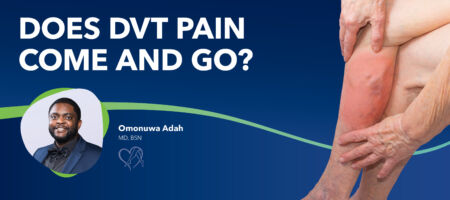
Medically reviewed by Omonuwa Adah, MD, BSN, on September 3, 2025
When a stubborn, lingering pain in your leg keeps returning, it’s natural to question whether it could signal a blood clot, or even deep vein thrombosis (DVT). Many people worry about DVT, and for good reason. Untreated DVT can lead to serious complications such as a pulmonary embolism (PE), which occurs when a blood clot travels to your lungs. But one of the most confusing things about DVT is how the pain behaves.
In this article, Omonuwa Adah, MD, BSN, lead physician at Center for Vein Restoration (CVR) in Hamilton, NJ, answers the question: Does DVT pain remain constant, or can it fluctuate? He explores how DVT pain typically feels, what causes these ups and downs, and, most importantly, how to know when it’s time to talk to a vein specialist.
In short, deep vein thrombosis (DVT) pain does not always follow a predictable pattern. For some, it’s a deep, constant ache. For others, the pain may ease at times and then return, fluctuating between moments of relief and uncomfortable tightness, swelling, or tenderness.
💬 Worried about recurring leg pain? Don’t wait. Schedule a consultation with the specialists at CVR today and find out what’s going on underneath the surface.
👉Book your consultation with Dr. Adah in Hamilton—CLICK HERE
👉 Book your consultation with a vein specialist at one of CVR’s 120+ locations today—CLICK HERE

DVT occurs when a blood clot forms in a deep vein, usually in the lower leg or thigh. This clot can partially or completely block the flow of blood, leading to symptoms that may start discreetly and worsen over time.
Common signs of DVT-related pain include:
Unlike sore muscles or minor injuries, DVT pain doesn’t usually improve with stretching, elevation, or rest. It also typically affects only one leg, making the discomfort more distinct and concerning.
Most of the time, DVT pain tends to be persistent or progressively worse over time. Other times, it may appear to come and go, which may create confusion for individuals experiencing a blood clot.
Here’s what might cause this fluctuation:
Keep in mind that actual on-and-off leg pain is not the most common presentation of DVT. Most cases involve a steady ache or pain that becomes more noticeable over time.
If your leg pain completely resolves and returns much later, it may point to a different issue, such as a muscle strain or nerve irritation. But if it comes with symptoms such as swelling, warmth, or skin discoloration, you should seek prompt medical evaluation. A vein specialist can determine whether a clot is present, even if your symptoms seem inconsistent.
CVR makes it easy to get answers fast with our DVT rule-out service, offering same-day or next-day diagnosis and treatment planning. Call 877-SCAN-DVT (877-722-6388) today.
DVT symptoms can shift from mild to severe. Warning signs that the condition may be worsening include:
If you notice any of these symptoms, especially with difficulty breathing or rapid heartbeat, seek emergency care immediately.
Several vein, nerve, and musculoskeletal conditions may look or feel like DVT. Knowing the difference is important because a missed diagnosis can delay the proper treatment and increase the risk of complications. Conditions with similar symptoms include:
Beyond affecting only one leg, DVT pain also tends to persist regardless of movement or posture.
You might notice that your symptoms change depending on the time of day or your activity level. For example, sitting or standing for long periods can make the discomfort worse, while elevating your leg may temporarily reduce swelling.
Other factors can also influence how DVT feels. Dehydration can slow circulation and increase discomfort, and inflammation levels in the body naturally rise and fall, which may affect pain and swelling as well.
IMPORTANT: Although these changes may give the impression that symptoms are improving, the underlying clot remains unless it is medically treated.
While DVT can happen to anyone, certain risk factors increase your chances. Understanding these can help you recognize symptoms earlier and take steps to prevent complications.
You may be at higher risk for DVT if you:
Knowing your risk factors is an important part of taking control of your vein health.
If you're diagnosed with DVT, your doctor will create a treatment plan to reduce the risk of complications and prevent future clots.
Common DVT treatment options include:
Early treatment protects your health today while helping prevent long-term complications such as post-thrombotic syndrome in the future, which can cause ongoing leg pain, swelling, and discomfort.
DVT pain doesn’t always follow a predictable pattern. For some, it’s constant and severe. For others, it might seem to disappear, only to return later. Either way, it’s not something to ignore.
At CVR, our board-certified vein experts use the latest technology and a caring approach to give you clear answers and the treatment that’s right for you.
✅ Don’t leave your vein health to chance. Book your consultation with CVR today and get clarity, confidence, and care that puts your health first. Click the button below or call a CVR Patient Services Representative at 240-965-3915 today to schedule a consultation at one of CVR’s 120+ vein clinics nationwide.
